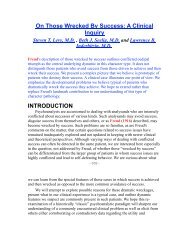A Sadomasochistic Transference - Beth J. Seelig, MD
A Sadomasochistic Transference - Beth J. Seelig, MD
A Sadomasochistic Transference - Beth J. Seelig, MD
You also want an ePaper? Increase the reach of your titles
YUMPU automatically turns print PDFs into web optimized ePapers that Google loves.
gratification from their sense of victimization, though he points out that many<br />
neurotic character formations serve such narcissistic functions.<br />
While Cooper emphasizes the narcissistic repair of masochistic pathology, he<br />
stops short of elucidating another important function—the preservation, albeit in<br />
distorted fashion, of connectedness and mutuality. It is here that Stern's concepts<br />
on the developmental process become important, focusing as they do not only on<br />
the child's need for increasing individuation, but also on its ongoing need for<br />
attunement, intersubjective communication, and mutual recognition with the<br />
mother. In her work on masochism, Benjamin (1989) points out that such an<br />
emphasis on mutuality "reintroduces the idea of pleasure, pleasure in being with<br />
the other, which had gotten lost in the transition from drive theory to ego<br />
psychology—but redefines it as pleasure in being with the other" (p. 31).<br />
In the course of development, then, the child seeks not only autonomy (as<br />
emphasized by Mahler), but also relatedness, mutuality, and mutual recognition (as<br />
emphasized by Stern). The achievement of authentic mutuality depends not only<br />
on recognition of the self (by the other), but also on the child's recognition of the<br />
other as separate. Benjamin (1989) presents an eloquent discourse on how the<br />
normal evolution of mutuality may sometimes be subverted by distortions in the<br />
mother-child dyad. For example, the mother may be unduly sensitive to a baby's<br />
unresponsiveness: "The mother who giggles, jokes, looms and shouts 'Look at me!'<br />
to her unresponsive baby creates a negative cycle of recognition out of her own<br />
despair… Here<br />
- 985 -<br />
in the earliest social interaction we see how the search for recognition can become<br />
a power struggle: how assertion becomes aggression… The child loses the<br />
opportunity for feeling united and attuned, as well as the opportunity for<br />
appreciating (knowing) his mother. He is never able to fully engage in or fully<br />
disengage himself from this kind of sticky, frustrating interaction… Even as he is<br />
retreating he has to carefully monitor his mother's actions to get away from them:<br />
even withdrawal is not simple." Benjamin concludes: "In a negative cycle of<br />
recognition, a person feels that aloneness is only possible by obliterating the<br />
intrusive other, that attunement is only possible by surrendering to the Other" (p.<br />
28). Put another way, autonomy only seems possible through domination of the<br />
other, while mutuality only seems possible through submission. Depending on the<br />
specific pathological interaction, one may see masochistic or sadistic distortions as<br />
an adaptative maneuver aimed at preserving autonomy or mutuality or, as in the<br />
case of Miss T., both (Person, 1988); (Benjamin, 1989).<br />
Our formulation is consonant with Cooper's, but we suggest that<br />
sadomasochistic defenses are mobilized to preserve mutuality (however distorted)




